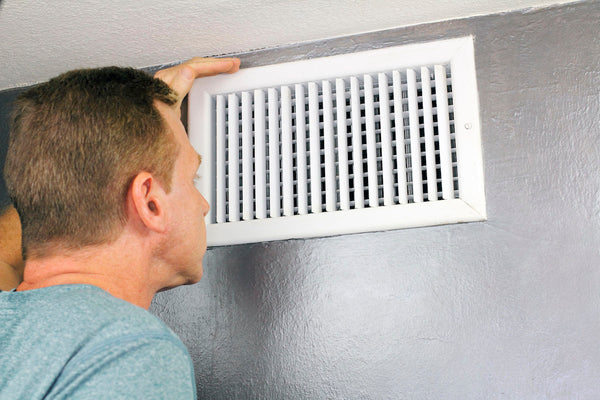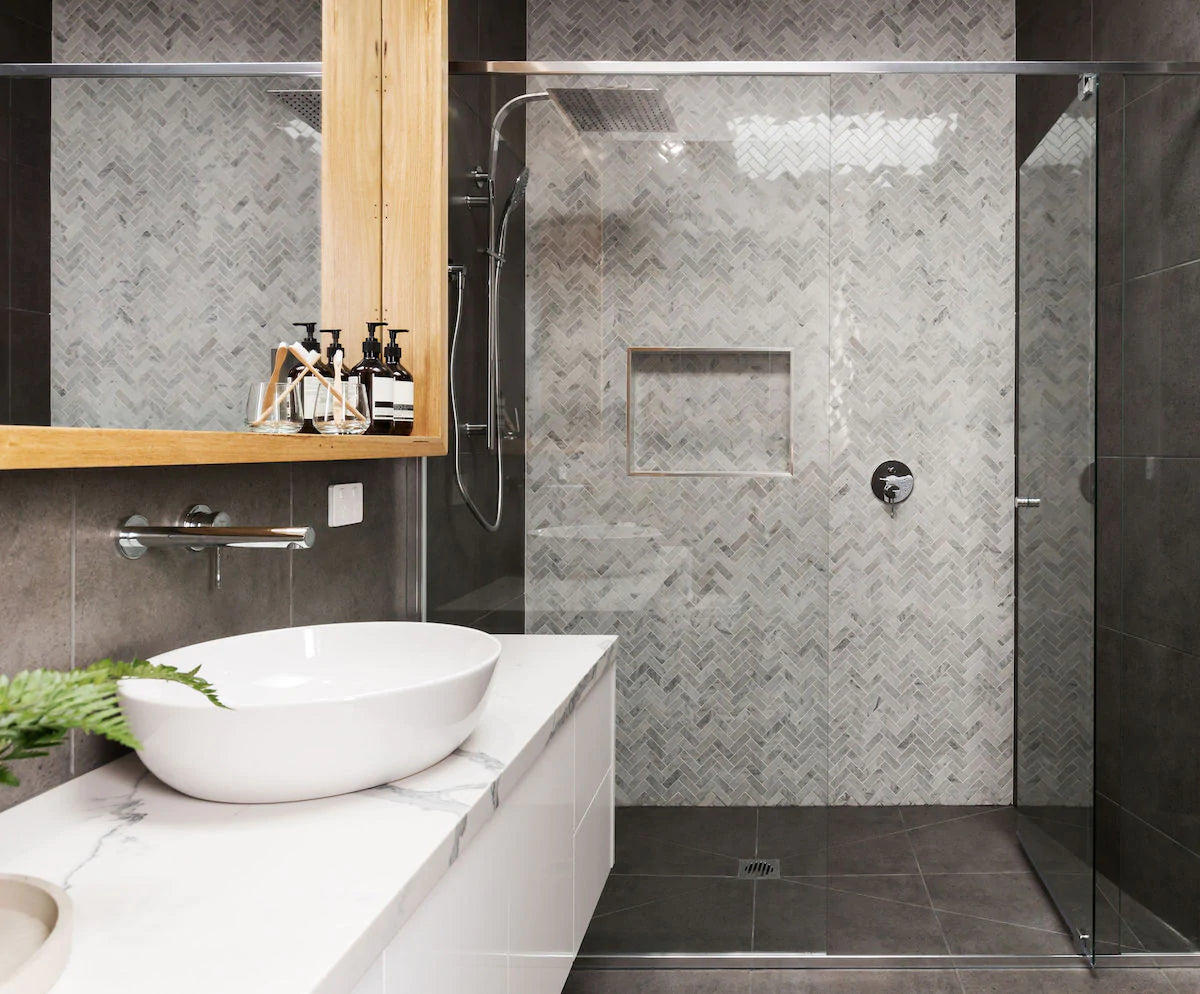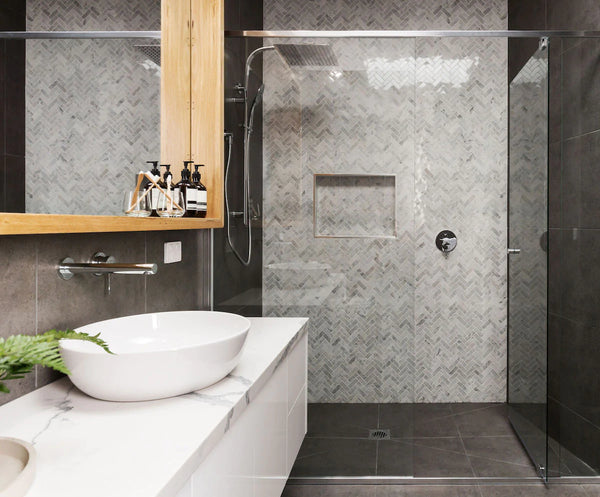It’s every homeowner’s dream: a bathroom with floor-to-ceiling windows overlooking a private stretch of beach, not a soul in sight. While magnificent, this dream isn’t realistic for most of us.
Instead, we’re often faced with bathroom designs that feature small windows — or none at all. Still, even in a windowless bathroom, creating a light-filled, airy and sophisticated atmosphere is possible. Here’s what you need to consider in your design.
Lights, Mirrors and Reflective Surfaces
Lighting is the most important element in a windowless bathroom. Without a stream of natural light, you’ll need to create a bright, yet welcoming effect with lamps and fixtures above the mirror to illuminate the vanity area. Smaller bathrooms will need additional lighting beyond the vanity, such as under the cabinets and on either side of the mirror, explains Jaclyn Crawford at ImproveNet.
Second to lighting, mirrors are essential for adding light, a sense of space and depth to your bathroom. Designate a wall for hanging a large mirror when designing the space. This will ensure that the mirror fits into space and is strategically placed.
A properly placed mirror will reflect light in the bathroom creating additional brightness, writes Kamla Villanueva at Homify. Putting mirrors on multiple walls enhances the sense of space and light even further.
Also consider placing the mirror directly opposite the doorway. This will reflect the light coming into the house from windows in other rooms, explains Apartment Therapy’s Adrienne Breaux. However, take care not to place mirrors directly opposite each other, as this can create a funhouse effect.
Another way to reap the benefits of mirrors and reflective surfaces is to design a bathroom with mirrors inlaid in the cabinetry. Large swaths of dense and non-reflective color absorbs light and makes a space feel darker, says Toronto Interior Design Group founder Yanic Simard. He suggests considering cabinet doors and drawers with inlaid lucite or other reflective materials.
“Polished metal, glass, mirror and Lucite are great materials for adding interest and drama without absorbing light. The space will feel uniform, even if there’s very little color,” he writes.

Smart Use of Color
Colors play an influential role in a bathroom’s lighting, too. Splashes of bold colors also make the entire space feel larger and brighter, according to the home improvement site Adorable Home. Colorful hues can be used on accent walls and in stripes or patterns to draw attention to certain areas and add more interest to an otherwise ordinary space. In spaces without windows, white is a formidable choice for creating a sense of space while reflecting and amplifying light.
“Keeping all surfaces, walls and finishes bright white is an obvious way of making a space feel light, but it’s one worth reiterating. Reflection and shine is your secret to success in a windowless space, as (artificial) light can be bounced around the room, making it feel immediately brighter,” explains interiors writer Louise O’Bryan at Houzz. She shows how a multi-tonal turqoise theme is paired with bright white to reflect light and maintain a fresh, crisp look in the space.
When using color, it’s important to avoid dark hues. Black bathrooms and navy blue powder rooms have seen a rise in popularity, but these work best when there is a window present. If you do choose to go dark, make sure there are bright lights throughout the bathroom to cast light in corners and keep the space feeling open.
Shower, Sink and Bath Tips
A shower curtain can make a bathroom feel smaller and darker than it actually is. Instead, design a bathroom with a sliding glass shower door, suggests Jennifer Noonan at BobVila.com. Or compromise with a transparent shower curtain.
The benefits of a glass shower door, however, is that it shows the area within the shower, revealing the full size of the space. Plus it’s reflective, so will bounce light around. Glass is also sleek and minimalist, and won’t add unnecessary bulk. You can obtain even more brightness by using light ceramic or porcelain tile in the shower and bathtub areas, adds Ronique Gibson at Decoist.
Windowless bathrooms need to have ample space and light available, so it’s important to have a strategy for keeping clutter at bay. Specifically, a pedestal sink or a floating sink will create more wall and floor space, making the room feel bigger and brighter. Ideal Home senior content editor Jennifer Lousie Ebert explains that wall-mounted, modular sinks are also great for storage. Modular sinks tend to be slightly wider than an average sink while opening up floor area beneath.

Ventilation Considerations in a Windowless Bathroom
In windowless bathrooms, ventilation is essential. Vents reduce moisture and prevent the growth of mold, explains the home retail and comparison site Smart Home Pick. “Anytime you take a hot shower, the vapor that is produced condenses and allows moist air to surface on cold places like the tiles, walls, mirrors and ceiling of the bathroom which then leads to the wide invitation of molds, bacteria and other health problems,” the team writes.
It’s clear that a vent is necessary, but how do you know which one to choose?
DIY expert Lee Wallender explains the parameters that a bathroom vent should meet. First, he says it that it should pull out at least 50 cubic feet per minute (cfm). Second, the exhaust fan cannot be routed through the crawlspace or attic. Instead, it must move air directly outside.The end of the vent run should also be fitted with a grille or screen to prevent vermin and other pests from entering the home.
HGTV’s John Riha provides a few more ideas for choosing a proper ventilation system. The air flow capacity, for example, depends on the size of the bathroom. A fan should have one cfm for every square foot of floor space. Plus, the noise level and energy efficiency of the fan can also narrow down options, depending on your preferences. Motion sensor vents, or those equipped with night lights or humidity sensors, are also options.
Another way to prevent moisture buildup in a windowless bathroom is to opt for hard, shiny, reflective surfaces. High gloss surfaces (such as the lucite tiles and cabinetry discussed earlier) make it more difficult for mold to attach itself, says Matt Hornyak at Homify. This is in contrast to softer materials like wood or porous rock, which are more prone to mold growth.
Images by: Jodie Johnson/©123RF.com, Katarzyna Białasiewicz/©123RF.com, Lee Serenethos/©123RF.com






